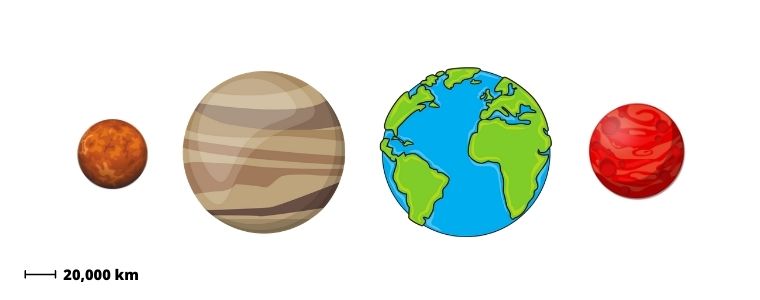The four closest planets to the Sun within our solar system are called the Terrestrial planets that are made up of Mercury, Venus, Earth, and Mars. There are many Terrestrial Planet Facts that we have come to discover over the many years of space expiration. The name Terrestrial comes from the word “telluric which is a Latin word “terra” and “tells” used to describe Earth. The Terrestrial Planets or inner planets are mostly composed of silicate rocks with solid surfaces, unlike the gas giants. Out of all four of the Terrestrial Planets, only Earth has water oceans however Mars possibly had liquid oceans in the past.
Terrestrial Planet Facts
- The terrestrial planets are Mercury, Venus, Earth, and Mars
- Terrestrial planets are also referred to as the “inner planets”
- Terrestrial planets are rocky planets
- The structure of the terrestrial planets are mainly iron core, surrounded by a mantle
- The surfaces are characterized by volcanoes, canyons, craters, and mountains
- Earth is the only terrestrial planet that has water on its surface.
- Mercury is the closest planet to the Sun
- Terrestrial plants have no ring system that surrounds them
- Earth has one moon, and Mars has two both Mercury and Venus have zero moons
- All the inner planets have impact craters created by collisions with space objects
- The atmospheres on Mars, Earth, and Venus can generate weather
- Despite Mercury being the closest planet to the Sun. Venus is the hottest planet.
- The Hubble space telescope can not view Mercury due to how close it is to the Sun
- Earth is the largest inner planet
- Terrestrial planets rotate slower than outer planets, which makes them more round
Terrestrial Planet Size

| Planet | Diameter | Distance from the Sun | Distance Traveled in One Orbit of The Sun | Single Orbit (Year Length) |
|---|---|---|---|---|
| Mercury | 3,030 miles | 36,800,000 miles | 223,700,000 miles | 3 Earth months. |
| Venus | 7,520.8 miles | 67,200,000 miles | 422,500,000 miles | 7 Earth months. |
| Earth | 7,917.5 miles | 93,000,000 miles | 584,000,000 miles | 1 Earth year. |
| Mars | 4,212.3 miles | 141,600,000 miles | 888,000,000 miles | 23 Earth months. |
Distances Between Terrestrial Planets
The distances between planets will vary depending on where each planet is in its orbit around the Sun. Sometimes they’ll be closer and other times, farther away!
The planets’ ellipses in the solar system have a huge impact on where their distances are from Earth. Mercury can be close to 77 million kilometers or far-reaching at 222 million km, making it tough to compute this distance for every planet and its orbit path.
The table below shows the four terrestrial planets and the average distance between them. The AU column is the distance in astronomical units.
1 AU is the distance from Earth to the Sun, which equates to 149.6 million kilometers.
Terrestrial Planets Distance Table
| FROM | TO | AU | KM | MILES |
|---|---|---|---|---|
| Mercury | Venus | 0.34 | 50,290,000 | 31,248,757 |
| Mercury | Earth | 0.61 | 91,691,000 | 56,974,146 |
| Mercury | Mars | 1.14 | 170,030,000 | 105,651,744 |
| Venus | Earth | 0.28 | 41,400,000 | 25,724,767 |
| Venus | Mars | 0.8 | 119,740,000 | 74,402,987 |
| Earth | Mars | 0.52 | 78,340,000 | 48,678,219 |




